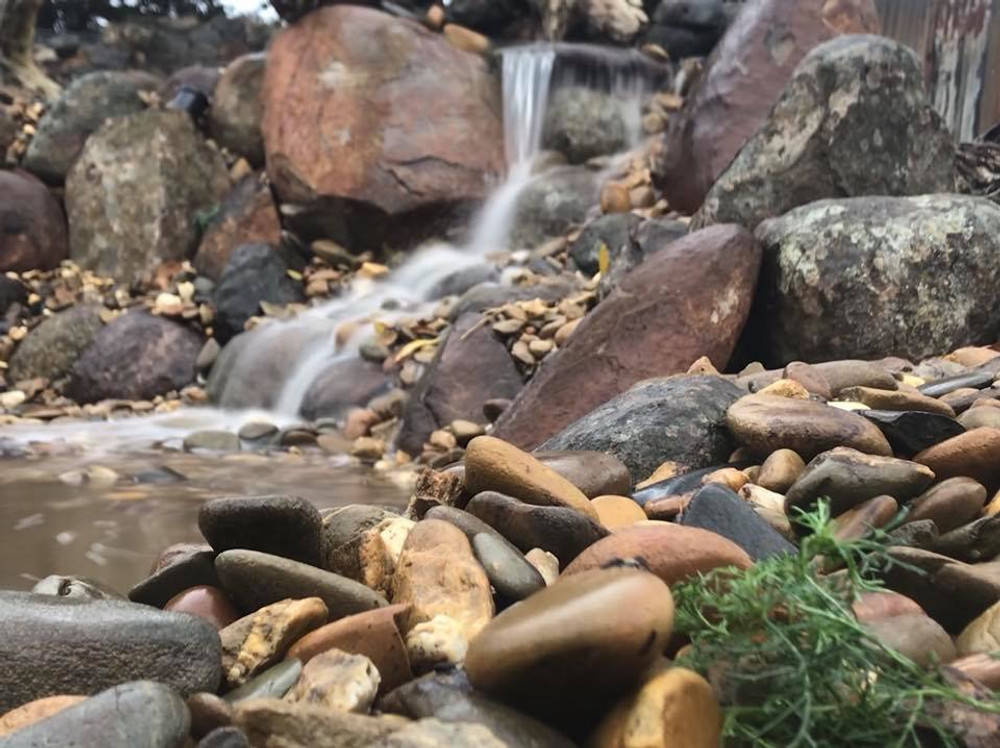12th May 2018
How to Build a Backyard Waterfall
Hey, everybody. Ed Beaulieu here. I've been designing and building waterfall features for more than 20 years. And today, I wanna show you just how easy it is to transform your outdoor living space using an Aquascape DIY Backyard Waterfall Kit.
Creating a beautiful backyard waterfall can be a great weekend project when
using an Aquascape DIY Backyard Waterfall Kit. The first step in building a
waterfall is to determine an appropriate location for your new feature. Once
you've determined a location, mark out the area for the reservoir basin that
holds the water that will re-circulate over your new waterfall. The waterfall
kit contains a Pondless Waterfall Vault that will house your pump, and two
AquaBlox that will make room for the water in your system and support the
decorative stone at the base of your disappearing waterfall.
Assembling the AquaBlox is easy and takes just a few minutes with no tools
required. Place one of the two large panels on the ground and evenly distribute
and connect the four small panels, as shown. Attach the second large panel on
the opposite side of the first, and complete the assembly by securing the two
side panels to the back and front sides of the module. Place the Pondless
Waterfall Vault and AquaBlox on the ground for reference, and outline the
components with brightly-colored spray paint, leaving a six-inch buffer for
ease of installation. Dig the space to a depth of 18 inches. The excavated soil
can be used to help build up the waterfall area, or discarded into a planting
bed.
Use a flathead shovel to carve straight walls within the basin and prepare a
separate cavity for the Pondless Waterfall Vault to sit eight inches lower than
the shelf created for the AquaBlox. Be sure to tamp the basin floor to create a
level base for the components, and make sure the vertical walls are cut
straight to avoid obstructions.
Now that the basin is excavated, place the units into the basin to check for
proper fit. The AquaBlox should sit level side by side on the basin shelf, with
one block extending over and resting on the foot of the Pondless Waterfall
Vault. With the excavation complete and the water basin created, you can
temporarily remove the components from the basin and install the underlayment
inliner. The underlayment is a thick woven fabric that will protect the bottom
of the liner from sharp rocks and tree roots. Unfold the underlayment and form
it to your basin, starting at the bottom.
Install the rubber liner the same way. Just be sure the excess material is
brought to one corner of the basin where you intend to build your waterfall.
Once the liner is set, you can place the basin components back into position on
top of the liner. Wrap the system by folding the liner and underlayment over
the top of the basin components, and proceed to backfill around the entire
perimeter of the basin with loose soil or sand. This will help lock the vault
and AquaBlox in place and avoid any shifting over time.
While the liner is folded back, dig a trench to accommodate the kink-free hose
that will connect the Pondless Waterfall Vault to the waterfall spillway. This
is also a good time to excavate an area for the waterfall that will fall into
your basin. The waterfall spillway is a diffuser that will make it easier to
create your waterfall. Once the waterfall area has been prepared, unfold the
liner and set a few larger rocks on top of the AquaBlox to frame out your
waterfall and retain the dirt on the backside of your basin. Install the pump
into the Pondless Waterfall Vault and hook up the plumbing. Attach the threaded
barbed fitting to the kink-free hose with the metal clamp provided, and run it
through the side discharge port to connect the plumbing to the pump below.
The hose can then be laid into the excavated pipe trench and stabilized in the
basin with gravel around the Pondless Waterfall Vault. Use a scrap piece of
underlayment around the pipe discharge port to prevent any gravel from falling
into the component. Finish securing the pipe with rock work and make sure the
area where the hose exits the basin is built up with dirt to avoid forming a
low edge that could cause a leak. Backfill the pipe trench with loose soil and
prepare the waterfall and stream area by carving out a path in the berm.
The use of a waterfall spillway provides a perfect start to build a
natural-looking waterfall. In preparation for setting the spillway, excavate a
flat area in your berm and tamp it down to prevent settling. Fold the liner
back and place framing rocks in the stream, using gravel to build up and level
the spillway. Continue building the waterfall and stream with various sized
rocks connecting the spillway to the basin.
Prepare the spillway to accept the plumbing by bringing the liner up over the
back of the unit, and use your finger to outline the intake on the liner. Use
scissors or utility knife to cut out the marked section of liner. Place the
rubber gasket over the threaded intake on the back of the spillway and slip the
liner over the fitting. Complete the seal by sliding the rubber gasket over the
component and threading on the plastic compression nut. Tighten down the
fitting with a pair of Channellock pliers and prepare to install the barbed
hose adapter by applying silicone to the threads of the component. Install the
adapter, and once again, tighten it down with Channellock pliers. A couple of
turns past hand tight should do the trick. Connect the kink-free hose to the
barbed fitting and secure the connection with the use of a metal clamp
provided. If connecting the hose to the barbed fitting proves to be too
difficult, soften the pipe by submerging it in warm water or heating it with a
hair dryer.
Once the plumbing is connected, wrap the liner around the spillway unit and
backfill the area with loose soil. Use a flat stone to help blend the spillway
into the landscape, or bring in plants to help naturalize it. Using waterfall
foam will improve the aesthetics of the waterfall by filling the gaps between
the rocks where water would naturally be lost. Apply the expandable foam into
the joints between the waterfall spillway and the framing rocks or the base of
any stones along the stream in waterfall where you want to divert the water
from disappearing behind the rock work. Wait 15 to 20 minutes for the outer
shell of the foam to harden before molding it down and using gravel to disguise
it.
Complete waterfall construction by adding gravel to the stream bed and add the
finishing touches by setting accent stones around the perimeter of the basin.
Once the accent stones are set, you can trim the excess liner and work on the
edging. Use different types of edge treatments to help naturalize your water
feature. A gravel edge can be done by trenching the liner around the perimeter
of the basin and backfilling the area with stone. A dirt edge involves folding
the liner back behind the perimeter of the rocks and backfilling the area with
soil, and eventually, mulch. Fill the basin with water and add plants to help
blend your new water feature into its surroundings. Once the water level has
reached the top of the basin, you can turn on the pump and see your landscape
come to life. Nothing helps transform an outdoor living space like a DIY Backyard
Waterfall Kit.

